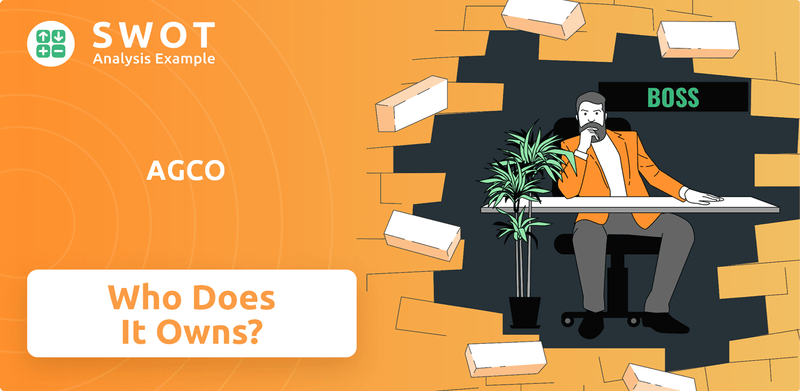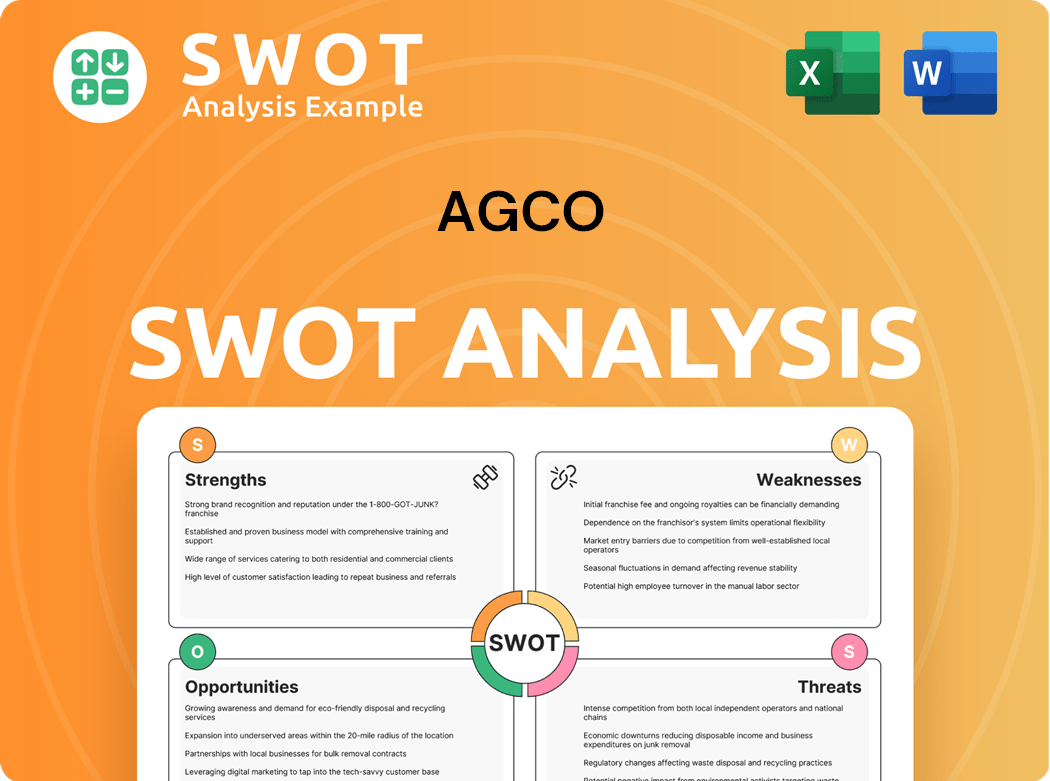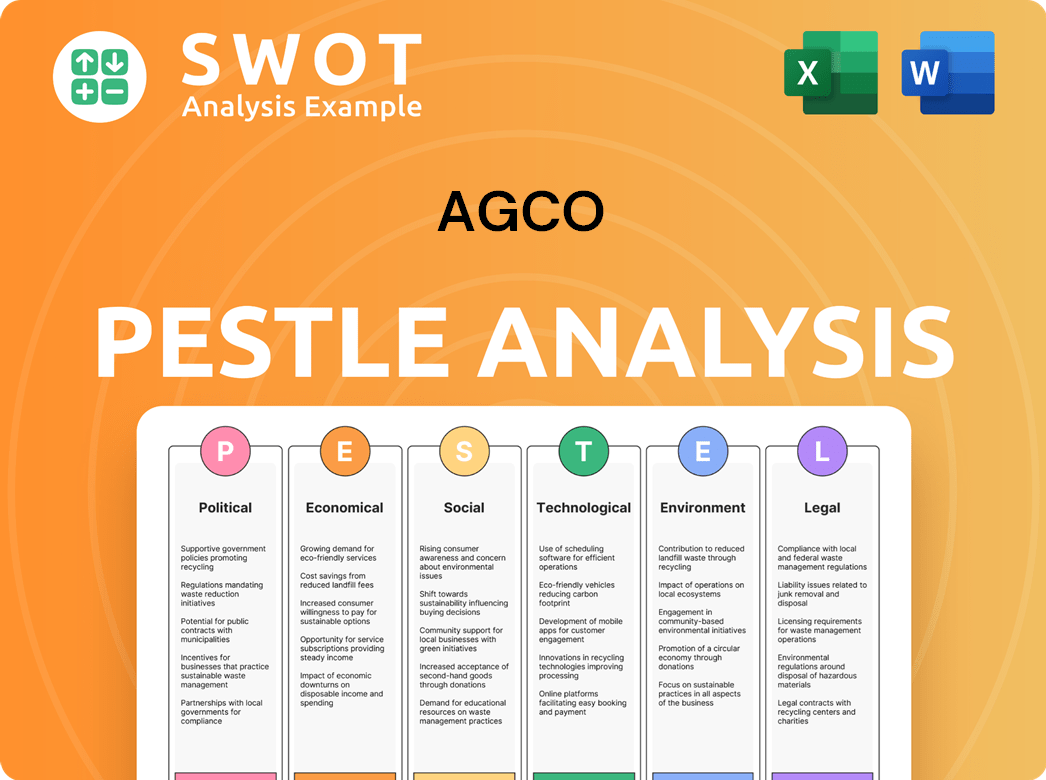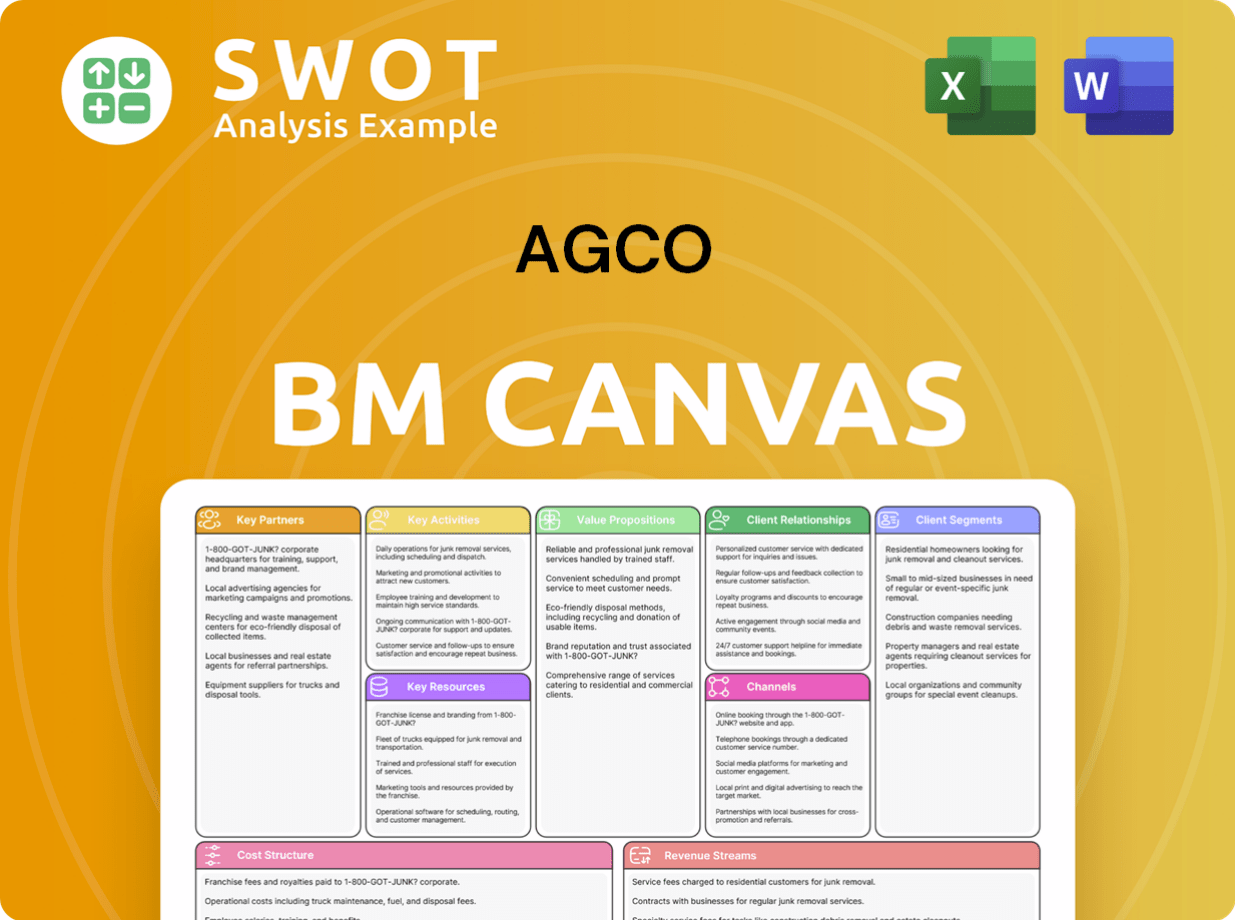AGCO Bundle
Who Really Calls the Shots at AGCO Corporation?
Understanding who owns a company is paramount to grasping its strategic ambitions and future prospects. AGCO Corporation, a global leader in agricultural equipment, presents a compelling case study in evolving ownership dynamics. From its inception as Deutz-Allis Corporation in 1990, AGCO has transformed into a major player, making its ownership structure a key area of interest for investors and industry watchers alike.

This exploration of AGCO SWOT Analysis will uncover the intricacies of AGCO ownership, from its historical roots to its current publicly traded status. We'll examine how AGCO ownership influences its governance, strategic decisions, and overall performance within the competitive landscape. By analyzing the AGCO stock and its key stakeholders, we aim to provide a comprehensive understanding of this agricultural giant, including AGCO brands, AGCO history, and the impact of its ownership on its future.
Who Founded AGCO?
The genesis of AGCO Corporation in 1990 stemmed from the acquisition of Deutz-Allis Corporation. This pivotal move was orchestrated by a cadre of former Deutz-Allis executives, marking the beginning of a new chapter for the agricultural equipment manufacturer. The early ownership structure was primarily shaped by this management buyout, setting the stage for AGCO's future trajectory.
The founding ownership of AGCO was rooted in the strategic vision of the management team that spearheaded the acquisition. These individuals, bringing their industry expertise and understanding of the agricultural market, formed the core of AGCO's initial ownership and leadership. Their experience was crucial in navigating the complexities of the acquisition and setting the company's strategic direction.
Details about the specific equity distribution among the founding executives are not readily available in public records. However, the formation of AGCO was a strategic acquisition and rebranding rather than a typical startup with diverse early-stage investors. The focus was on acquiring the North American operations of Deutz-Allis from KHD (Klöckner-Humboldt-Deutz AG), which involved agreements for asset transfers and potentially liabilities. This laid the groundwork for AGCO's operational framework.
The initial ownership of AGCO was primarily vested in the management team responsible for the acquisition of Deutz-Allis. This structure underscored their commitment and vision for the company. The founding team's vision was centered on building a strong, independent agricultural equipment company. This concentrated control in the acquiring management group was a key feature of this initial phase.
- The acquisition of Deutz-Allis in 1990 was a pivotal moment, leading to the formation of AGCO Corporation.
- The early ownership structure was largely shaped by the management buyout, with the key figures being former Deutz-Allis executives.
- Initial agreements with KHD (Klöckner-Humboldt-Deutz AG) involved asset transfers and potentially liabilities.
- The founding team's vision for AGCO was focused on creating a strong, independent agricultural equipment company.
AGCO SWOT Analysis
- Complete SWOT Breakdown
- Fully Customizable
- Editable in Excel & Word
- Professional Formatting
- Investor-Ready Format

How Has AGCO’s Ownership Changed Over Time?
The evolution of AGCO Corporation's ownership structure reflects its journey from a privately held entity to a publicly traded company. The initial public offering (IPO) was a pivotal moment, transforming the company's ownership base. This transition opened the door for a diverse group of investors, including institutional and individual shareholders, to participate in AGCO's growth.
Since the IPO, AGCO ownership has been primarily characterized by institutional investors. These include large asset management firms, mutual funds, and index funds, which collectively hold a significant portion of the outstanding shares. This shift towards institutional ownership has influenced AGCO's strategic direction and corporate governance practices, emphasizing shareholder value and transparency. This is a common trend among large publicly traded companies, reflecting a broad market confidence in their long-term prospects. The company's history is marked by strategic acquisitions and expansions, which have further shaped its ownership dynamics.
| Event | Impact on Ownership | Date |
|---|---|---|
| Initial Public Offering (IPO) | Transitioned from private to public ownership, opening shares to a wider investor base. | 1990s |
| Institutional Investment Growth | Increased influence of institutional investors on corporate governance and strategy. | Ongoing |
| Shareholder Value Focus | Emphasis on maximizing shareholder returns and implementing best corporate governance practices. | Ongoing |
As of March 31, 2025, key institutional holders of AGCO stock include The Vanguard Group, Inc., holding approximately 11.7% of shares, BlackRock, Inc. with around 9.9%, and State Street Corporation, which holds about 5.1%. These figures illustrate the significant influence these major stakeholders have on AGCO Corporation's strategic decisions. The engagement of these investors on issues like executive compensation and ESG initiatives further underscores the importance of their role. You can learn more about the company's growth strategy by reading Growth Strategy of AGCO.
AGCO's ownership structure has evolved significantly since its IPO, primarily driven by institutional investors. The company's governance and strategic direction are heavily influenced by these major stakeholders. Understanding the ownership dynamics is crucial for investors and stakeholders alike.
- Institutional investors hold a significant portion of AGCO's shares.
- Major stakeholders include The Vanguard Group, BlackRock, and State Street Corporation.
- Shareholder value and corporate governance are key priorities.
- The company's history includes strategic acquisitions.
AGCO PESTLE Analysis
- Covers All 6 PESTLE Categories
- No Research Needed – Save Hours of Work
- Built by Experts, Trusted by Consultants
- Instant Download, Ready to Use
- 100% Editable, Fully Customizable

Who Sits on AGCO’s Board?
The current board of directors of AGCO Corporation is pivotal in guiding the company's governance and strategic direction. As of early 2025, the board is composed of individuals with varied backgrounds and expertise, ensuring a comprehensive approach to decision-making. The board's structure emphasizes independent oversight, with the current Chairman serving in an independent capacity. This setup is designed to promote effective governance and align the interests of the board with those of the shareholders.
The board's composition is designed to support sound corporate governance and align the interests of the board with those of the broader shareholder base. The board members bring a wealth of experience from diverse fields, including manufacturing, finance, and international business, which is crucial for overseeing AGCO's global operations. The board's role includes overseeing strategic initiatives, risk management, and ensuring the company's long-term sustainability and shareholder value creation. The board regularly reviews and approves the company's financial performance, strategic plans, and major corporate transactions.
| Board Member | Title | Relevant Experience |
|---|---|---|
| Martin Richenhagen | Chairman of the Board | Former Chairman, President, and CEO of AGCO |
| Eric Hansotia | President, CEO, and Director | Extensive experience in agricultural machinery and technology |
| Roger N. Biffar | Lead Independent Director | Experience in financial management and corporate governance |
AGCO operates under a one-share-one-vote structure, which is standard for publicly traded companies in the United States. This structure means that each share of common stock carries one vote, ensuring that voting power is directly proportional to the number of shares owned. This system promotes a more equitable distribution of voting power among shareholders. This structure promotes a more equitable distribution of voting power among shareholders. There are no indications of dual-class shares or special voting rights that would grant outsized control to any individual or entity. This approach helps maintain a level playing field for all investors, regardless of their stake in the company.
The board of directors plays a crucial role in AGCO Corporation's governance and strategic oversight, ensuring the company's stability and growth. The one-share-one-vote structure promotes equitable voting power among shareholders. Learn more about the Brief History of AGCO.
- Board composition emphasizes independent oversight.
- One-share-one-vote structure ensures fair voting.
- Focus on operational performance and shareholder value.
- No recent proxy battles or activist campaigns.
AGCO Business Model Canvas
- Complete 9-Block Business Model Canvas
- Effortlessly Communicate Your Business Strategy
- Investor-Ready BMC Format
- 100% Editable and Customizable
- Clear and Structured Layout

What Recent Changes Have Shaped AGCO’s Ownership Landscape?
In the past few years, AGCO Corporation has demonstrated a consistent approach to capital allocation, primarily through share buybacks. This strategy aims to return value to shareholders and optimize the company's financial structure. For example, in its Q1 2024 earnings report, AGCO announced ongoing share repurchases, indicating a continued commitment to this practice. While there haven't been significant secondary offerings, the company actively manages its equity through various financial activities.
Mergers and acquisitions continue to be a strategic tool for AGCO, with recent activities focusing on enhancing existing product lines and technological capabilities. A notable example is the joint venture with Trimble, named PTx Trimble, announced in September 2023 and expected to close in the first half of 2025. AGCO will hold an 85% stake in this venture, with Trimble holding 15%, which shows a strategic investment to advance its precision agriculture offerings. This move will significantly impact AGCO's operational control and future revenue streams within a key growth area.
| Aspect | Details | Impact |
|---|---|---|
| Share Buybacks | Ongoing repurchases announced in Q1 2024 | Returns value to shareholders, optimizes capital structure |
| Joint Venture (PTx Trimble) | AGCO holds 85% stake, Trimble 15% | Enhances precision agriculture offerings, impacts revenue |
| Ownership Structure | Primarily diffused among institutional and retail investors | Stable ownership profile, limited activist investor influence |
Industry trends in the agricultural equipment sector, including AGCO, show an increase in institutional ownership. This means that large asset managers hold significant stakes in the company. While founder dilution is natural for publicly traded companies, AGCO's ownership is primarily spread among institutional and retail investors. The company has maintained a stable ownership and governance profile, without significant public activist campaigns in recent years. AGCO's public statements and analyst coverage continue to focus on its market position, technological advancements, and efforts to meet global food production demands. The company's focus on innovation and strategic partnerships, such as the joint venture with Trimble, is key to its long-term growth and market leadership.
AGCO stock performance is closely watched by investors. The stock price history reflects the company's strategic moves and market conditions. Investors can find detailed financial information and stock price analysis to make informed decisions about investing in AGCO.
Understanding AGCO ownership involves looking at the major shareholders, including institutional investors. These investors significantly influence the company's strategic direction and financial performance. Analyzing the key players helps to understand the company's stability and growth potential.
AGCO's strategic partnerships, like the joint venture with Trimble, are crucial. These collaborations enhance AGCO's technological capabilities and market reach. These partnerships support AGCO's efforts to innovate and meet the evolving needs of the agricultural sector.
The influence of institutional investors on AGCO is significant. Their investment decisions can affect the company's stock price and strategic direction. This focus contributes to the company's financial stability and growth potential.
AGCO Porter's Five Forces Analysis
- Covers All 5 Competitive Forces in Detail
- Structured for Consultants, Students, and Founders
- 100% Editable in Microsoft Word & Excel
- Instant Digital Download – Use Immediately
- Compatible with Mac & PC – Fully Unlocked

Related Blogs
- What are Mission Vision & Core Values of AGCO Company?
- What is Competitive Landscape of AGCO Company?
- What is Growth Strategy and Future Prospects of AGCO Company?
- How Does AGCO Company Work?
- What is Sales and Marketing Strategy of AGCO Company?
- What is Brief History of AGCO Company?
- What is Customer Demographics and Target Market of AGCO Company?
Disclaimer
All information, articles, and product details provided on this website are for general informational and educational purposes only. We do not claim any ownership over, nor do we intend to infringe upon, any trademarks, copyrights, logos, brand names, or other intellectual property mentioned or depicted on this site. Such intellectual property remains the property of its respective owners, and any references here are made solely for identification or informational purposes, without implying any affiliation, endorsement, or partnership.
We make no representations or warranties, express or implied, regarding the accuracy, completeness, or suitability of any content or products presented. Nothing on this website should be construed as legal, tax, investment, financial, medical, or other professional advice. In addition, no part of this site—including articles or product references—constitutes a solicitation, recommendation, endorsement, advertisement, or offer to buy or sell any securities, franchises, or other financial instruments, particularly in jurisdictions where such activity would be unlawful.
All content is of a general nature and may not address the specific circumstances of any individual or entity. It is not a substitute for professional advice or services. Any actions you take based on the information provided here are strictly at your own risk. You accept full responsibility for any decisions or outcomes arising from your use of this website and agree to release us from any liability in connection with your use of, or reliance upon, the content or products found herein.